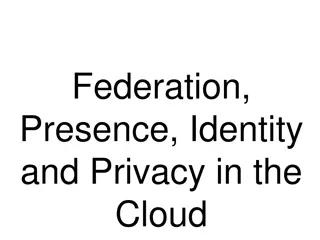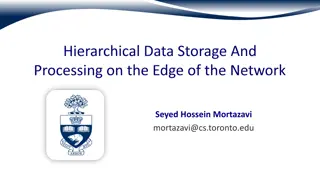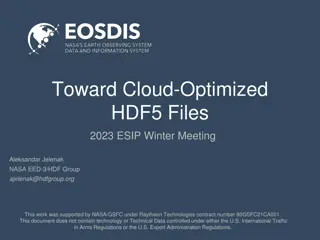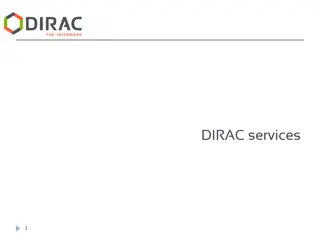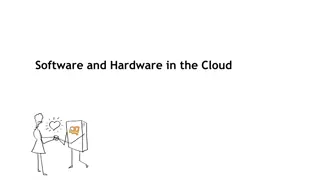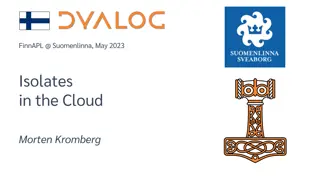GRID AND CLOUD COMPUTING
"Explore Amazon Web Services Platform as a Service (PaaS) with a focus on components like SimpleDB, SQS, SNS, and CloudFront. Learn about the capabilities, architecture, and usage scenarios of Amazon SimpleDB (SDB) for structured data storage in cloud computing environments, along with key features and considerations for developers."
Download Presentation

Please find below an Image/Link to download the presentation.
The content on the website is provided AS IS for your information and personal use only. It may not be sold, licensed, or shared on other websites without obtaining consent from the author.If you encounter any issues during the download, it is possible that the publisher has removed the file from their server.
You are allowed to download the files provided on this website for personal or commercial use, subject to the condition that they are used lawfully. All files are the property of their respective owners.
The content on the website is provided AS IS for your information and personal use only. It may not be sold, licensed, or shared on other websites without obtaining consent from the author.
E N D
Presentation Transcript
GRID AND CLOUD COMPUTING Courtesy of Professor Ahmed Ezzat, Ph.D Amazon Web Services PaaS http://web.uettaxila.edu.pk/CMS/FALL2017/teGNCCms/ 1 www.svuca.edu
UNIT 17: Amazon Web Services PaaS Introduction Amazon Web Services (AWS) Components: IaaS: EC2, S3, EBS PaaS: SimpleDB, SQS, SNS, CloudFront, Relational Data SaaS: AWS Web Services AWS Integration and Management AWS Billing AWS Scalability AWS Application Architecture: Design to Scale using AWS Elastic Features Summary and Conclusions 2
PaaS: Amazon SimpleDB (SDB) SDB is available for more structured data; it does not support schema but instead defines Domains with items that consist of up to 256 attributes/values. A value can be up to 1 KB. SDB supports simple operators such as: =, !=, <, >, <=, >=, STARTS- WITH, AND, OR, NOT, INTERSECTION, and UNION SDB is a distributed, highly scalable, light-weight, query-able, attribute store new style of DB for cloud CAP: Consistency: Availability: network-Partitioning Cloud DB needs to sacrifice traditional DB CAP (consistency) properties: client side, Server side, and Eventual 3
PaaS: Amazon SimpleDB (SDB) The SimpleDB Model 4
PaaS: Amazon SimpleDB (SDB) Developers want to: Store data Process data Query data Probably don t want: Schema management Index management Performance tuning Data access scaling All data is replicated in geographically disbursed data centers (no explicit backup). Requests use HTTPS (security) Complex JOIN applications (DW) are not a good match for SimpleDB 5
PaaS: Amazon SimpleDB (SDB) Architecture: Attributes: name/value pair, multiple values per name Items: consists of multiple attributes, can have different set of attributes for each item in domain Domain: elastic table structure no schema is required Ability to improve your data model dynamically as needed basis makes SimpleDB a perfect match for agile development Flexible dynamic schema data model 6
PaaS: Amazon SimpleDB (SDB) PutAttributes(Joe:(Hair:Red)); PutAttributes(Sarah:(Age:13)); 7
Amazon SimpleDB item 123 456 789 description Sweater Dress shirt Shoes color Blue, Red White, Blue Black material Leather PUT (item, 123), (description, Sweater), (color, Blue), (color, Red) PUT (item, 456), (description, Dress shirt), (color, White), (color, Blue) PUT (item, 789), (description, Shoes), (color, Black), (material, Leather) Query Domain = MyStore [ description = Sweater ] 8
PaaS: Amazon Simple Queue Service (SQS) Scalable Queuing Elastic Capacity Reliable, Simple, Secure $.10 per 1000 messages $.10 - $.18 per GB data transfer Inter-process messaging, data buffering, architecture component 9
PaaS: Amazon Simple Queue Service (SQS) - Overview A distributed queue in the cloud Used for storing messages traveling between computers Reliable: Runs within Amazon's high-availability data centers Messages are stored redundantly across multiple servers and locations Scalable to millions of messages a day Simple: Only 6 methods Platform agnostic Provides access control and message locking 10
PaaS: Amazon Simple Queue Service (SQS) - Amazon SQS Concepts Queues: Named message container Persistent Messages: Up to 256KB of data per message Peek / Lock access model Scalable: Unlimited number of queues per account Unlimited number of messages per queue 11
PaaS: Amazon Simple Queue Service (SQS) - Amazon SQS Concepts 12
PaaS: Amazon Simple Queue Service Application Architecture: Design to Scale using AWS Elastic Features 13
PaaS: Amazon Simple Queue Service SQS SOAP / Query API Queues: ListQueues DeleteQueue SetVisibilityTimeout GetVisibilityTimeout Messages: SendMessage ReceiveMessage DeleteMessage PeekMessage Security: AddGrant ListGrants RemoveGrant 14
PaaS: Amazon Simple Notification Service - SNS Overview SNS provides publish/subscribe messaging functionality SNS is a distributed and redundant service that enables applications, end-user, and devices to send and receive notifications from the cloud The service works on specified topics, which are Universal Resource Identifier (URIs) that specify communication channels based on content or event types Any web server, email address, or SQS queue can subscribe to notification messages associated with a particular topic Authorized publishers can post messages to the channel and they will automatically be delivered to all subscribers 15
PaaS: Amazon CloudFront (~Akamai) Overview CloudFront is a web service for content delivery; both static and streaming content Requests for objects are automatically routed to the nearest edge location CloudFront is optimized to work with other Amazon services like S3, EC2, but also it works with servers hosted by other providers CloudFront objects are organized into distributions. A distribution specified the location of the original version , unique domain name (e.g., abc123.cloudfront.net) or map a proprietary domain (e.g., images.example.com) Distributions can either download definitive content from the origin server (HTTP/HTTPS) or stream the content using RTMP protocol 16
PaaS: Amazon Relational Data Overview Significant portion of use cases involve data in tabular form and may include cross reference between tables Scalability vs Integrity: SQL supports complex queries for transactional, normalized and uniform data. On the other hand, SQL is not appropriate for unstructured data (e.g., enforcing schema consistency). In cloud, data is changing fast for SQL engine to manage if all relations/schema need to be fully enforced The above limitation can be summarized as there is a need for systems to manipulate and analyze huge amount of data w/o impacting availability, performance or throughput In other words, SQL is good engine but it is difficult to scale-out to process huge amount of data and with schema-less environment; hence NoSQL initiative like Google BigTable 17
PaaS: Amazon Relational Data Overview NoSQL is a linear approach that has the potential of scaling much higher but also bring with it new set of scalability challenges (such as overloaded keys or heavy use of indexes, constraints enforcement are left to applications) Query Model Software-based Examples Service-based Examples SQL LAMP/MySQL Windows/SQL Server Oracle Amazon RDS MS/SQL Azure Zoho CloudSQL PseudoSQL Amazon SDB Google GQL Datastore MS Azure storage NoSQL Hypertable Hbase MongoDB CouchDB 18
PaaS: Amazon Relational Data Amazon Relational DB Service (RDS) RDS is a web service that makes it easy to set up, operate, and scale an RDBMS in the cloud RDS gives you compatibility with (access to the capabilities of a familiar) MySQL, Oracle or MS SQL Server. Applications and tools can be used with RDS storing the backups for a user defined retention period and enable point-in-time recovery consistent IO performance (up to 10,000 IOPS per DB instance) RDS reduces the time-consuming administration tasks RDS automatically patches the database software and backs up your database; IOPS is a new storage option for RDS designed to deliver fast, predictable and 19
PaaS: Amazon Relational Data Amazon Relational DB Service (RDS) RDS DB can be provisioned with either standard storage or IOPS storage Multi-AZ (Availability Zones) deployment option allows you to run mission critical workloads with high availability and built-in automated fail-over from your primary database to a synchronously replicated secondary database in case of failure deployment for read-heavy DB workloads RDS makes it easy to use replication to enhance availability and reliability. RDS for MySQL enables you to scale-out beyond the capacity of a single DB There is no up-front investment required; pay-per-usage 20
Thank You Questions and Comments? http://web.uettaxila.edu.pk/CMS/FALL2017/teGNCCms/ 21


